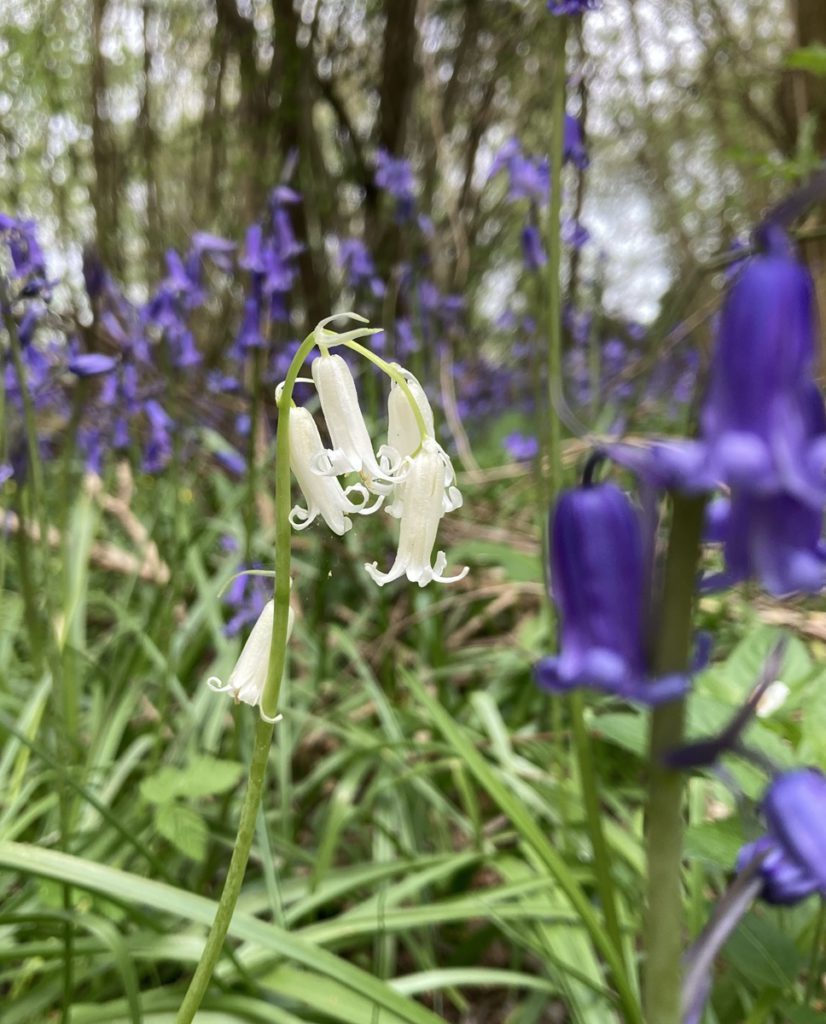LAUNDE PARK WOOD (Saturday 27.04.24)
 A very cool and grey April morning, (7 degrees) and 11 x members, some longstanding, some quite new to RNHS, one guest, and leader Sarah Bedford Senior Reserves Officer, met at the gate to Launde Park Wood. Sarah introduced us to the history of the wood, parts of which date from the sixteenth century and before, a hunting park set up by the monastery at Launde abbey, and much of it clear felled during the second world war. The management of the wood is to try to coppice small areas, called coups, every ten to fifteen years to allow more open areas for the benefit of ground dwelling plant species and insects which need a certain amount of light to thrive.We were greeted by the sound of a great spotted woodpecker drumming, and the sound was repeated many times during the morning, and at one point some of us were lucky enough to see one of these birds high in the branches of one of the ash trees, ( Fraxinus excelsior) very late to come into leaf this year because of the cold spring. Some of the ash trees were also victims of ash dieback disease (Hymenoscyphus Fraxinus)
A very cool and grey April morning, (7 degrees) and 11 x members, some longstanding, some quite new to RNHS, one guest, and leader Sarah Bedford Senior Reserves Officer, met at the gate to Launde Park Wood. Sarah introduced us to the history of the wood, parts of which date from the sixteenth century and before, a hunting park set up by the monastery at Launde abbey, and much of it clear felled during the second world war. The management of the wood is to try to coppice small areas, called coups, every ten to fifteen years to allow more open areas for the benefit of ground dwelling plant species and insects which need a certain amount of light to thrive.We were greeted by the sound of a great spotted woodpecker drumming, and the sound was repeated many times during the morning, and at one point some of us were lucky enough to see one of these birds high in the branches of one of the ash trees, ( Fraxinus excelsior) very late to come into leaf this year because of the cold spring. Some of the ash trees were also victims of ash dieback disease (Hymenoscyphus Fraxinus)

Horsetail – probably Wood Horsetail
The group set off to walk through the woodland, seeing horsetail plants alongside the path, and a little further along lesser celandine flowers. Sarah had looked up the folklore regarding this particular plant, which opens only through the middle of the day, and when the sun shines, and closes when it rains. The tubers are considered to resemble figs, hence its name ficaria. Its historic uses, including a treatment for piles stem from the look of the roots too! In modern medicine it is used for certain skin conditions. Parts of the wood were blue with forget-me-nots, and other areas blue with bluebells. Again Sarah’s research told us that there are many different names for bluebells, including fairy flowers, cuckoo’s boots and witches thimbles. Bluebells were used traditionally as diuretics, to increase urination or as a styptic, to aid healing of wounds, but modern medicine doesn’t use them, as the sap is poisonous.
A large bracket fungus was observed on a birch, a hoof fungus also known as tinder bracket, and behind the same tree some old birch polyphores and later the remains of puffballs on a tree stump. The bracken was just emerging in some places, and some were growing in a cup between forking branches of a hazel. When approached to photograph a small frog hopped away into the dead leaves. As well as hazel ash and birch trees there were several hawthorn trees, One hawthorn just  coming into flower, with a more delicate look than the more common hawthorn was identified as midland hawthorn, an indicator species for ancient woodland, and more tolerant of shade. The midland hawthorn is identified by its less deeply lobed leaves, and has two stigmas rather than one in the common variety.
coming into flower, with a more delicate look than the more common hawthorn was identified as midland hawthorn, an indicator species for ancient woodland, and more tolerant of shade. The midland hawthorn is identified by its less deeply lobed leaves, and has two stigmas rather than one in the common variety.
By a small stream in one of the steep valleys were a few plants of the small bright green/ yellow opposite leaved golden saxifrage, and spotted on the opposite bank was a small white flowered plant with fern like leaves, later identified as wavy bittercress.
One of the highlights of the walk was seeing a red kite flying overhead, and spotting a large nest, with a the back of a bird visible over the rim, possibly the female brooding young or eggs.
After a pleasant walk we finally made our way up steep muddy banks, helped by willing hands, and followed the footpath back to the gate to go home and get warm, but having enjoyed the chance to visit this lovely wood. Our thanks to LRWT and Sarah for managing and allowing us to visit the wood, and for leading so well.
Report by Linda Biddle